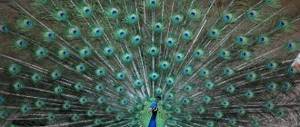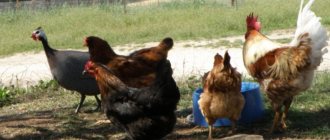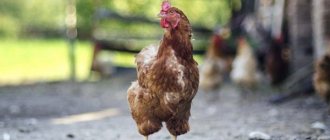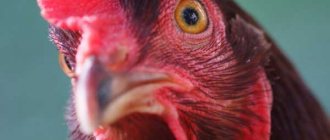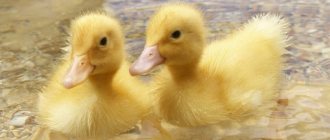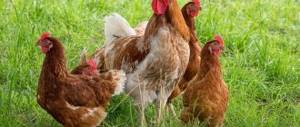Home » Articles about guinea fowl » Guinea fowl: how to distinguish a female from a male
To ensure a high percentage of fertilized eggs, a guinea fowl family is formed from 5 females and 1 male. They can be distinguished at an early stage. Behavioral reactions and visual characteristics are taken into account.
Primary sexual characteristics
Already 6 hours after birth, it is not difficult to find out the gender of the bird:
- The chick is picked up and gently pressed on the stomach to free the cloaca from feces (they are removed using a napkin);
- stroke the back to reassure - if this is not done, then due to muscle spasm, the examination will cause pain to the chick;
- turn over and open the cloaca for inspection.
Inspection of chicks is carried out using sterile gloves to avoid infection.
On the inside of the cloaca, males have a tubercle - it is clearly visible. In females, the genital loop is pink and there is no tubercle.
Sex differences in young animals
It is generally accepted that it is possible to distinguish the sex of guinea fowls only when they reach three months of age; until then, there are no differences. Exceptions include certain species of this bird. For example, Volga cream and white guinea fowl, their male plumage is lighter.
And yet, experienced poultry farmers who have been breeding the royal bird for many years can distinguish the sex of even day-old chicks. The main features are the external genitalia, since the color of the chicks in both females and males is almost identical.
The differences are as follows:
- in males, the genital organ looks like a small tubercle, which, even at this age, is already well developed;
- in females there are no outgrowths of any kind.
You need to act according to the following scheme. The chick is very carefully and carefully taken into one and stroked on the back with the other, then the tail moves aside and the cloaca opens. At the moment, blood flows into the tail part, as a result, the tubercle of the genital organ begins to fill with blood and this forces it to stick forward a little. If you have a female guinea fowl in your hands, the tubercle will not appear.
If there is a tubercle it means it's a male
Such a procedure may seem complicated at first glance, but in practice it is not difficult to master even from the first examination. The main thing is not to scare the guinea fowl, since almost all breeds of this bird are very shy.
When trying to determine the sex, catch and handle them with extreme care, while keeping the room quiet.
Size
Up to 3-4 months, the birds are almost the same in size, but after this period you can notice differences - females become slightly larger than males, which is not typical for other types of poultry. The difference in weight is negligible. An adult male weighs about 1.5 kg, a female – 1.6-1.7 kg. There may be no difference in weight - in this case you have to focus on external characteristics and behavioral factors.
Why gender determination is important
Identifying female or male individuals is an advantage for the farmer, because having learned this, you:
- Stop being bait for fraudulent sellers who want to misrepresent a female as a male.
- You will be able to properly build a business on breeding unique, undemanding birds, creating the desired sex ratio in the population. Since there is one male for every five females, it is not difficult to calculate that for a flock of 20 female birds, only 4 male birds will be needed.
How to distinguish male and female guinea fowl!!!!
How to distinguish the sex of guinea fowl.
Determination of sex in guinea fowls
Determining the sex of guinea fowl in Balakovo
guinea fowl sex determination.wmv
Now you know that sexing guinea fowl is important for the farmer. After all, females are more valuable representatives of the species than males
We hope that this review will help you correctly determine the gender of your birds.
When a farmer just starts raising guinea fowl, how to correctly distinguish a female from a male is one of the key problems that he needs to learn to solve. Many experts believe that it is almost impossible to find out exactly how many guinea fowl and guinea fowl you have acquired in the first months of their life. All differences are relative, and as the young animals develop, you may one day realize that you did something wrong. A common belief is that you can find out the sex of a chick only when it is at least three months old.
However, an experienced poultry farmer who has been raising guinea fowl for many years can easily cope with this task, even if he is dealing with day-old chicks. The main thing here is to pay attention to the external genitalia. Appearance and coloring are not helpful to you, since you definitely won’t be able to distinguish between females and males this way.
Find out how females differ from males, and you can learn how to determine the sex of guinea fowl when the need arises.
Visual differences
Females have an elegant, small beak, and the nostrils are not turned out. The skin covers the base of the beak, the tuberosity is practically absent. Males have a larger beak, the base is covered with bright red skin, and the nostrils are very prominent.
When moving, males move their heads forward and bend slightly. Females are held upright. The comb of guinea fowl is small and neat. It is located straight. In males, the crest is slightly raised above the head and slanted back. The size also differs - the male’s crest is slightly larger.
In guinea fowl, the earrings located under the beak are small, even, they fall down without sticking out to the sides. The color is the same as the skin above the beak - orange or pale pink.
The male's earrings are fleshy, large, and bright red at the edges. They diverge almost horizontally to the sides of the beak, and the edges descend vertically downwards.
How to distinguish a female from a male?
Knowing a number of characteristic signs, it is still possible to distinguish guinea fowl. There are many ways to distinguish the sex of individuals.
To size
Unlike other types of poultry, in guinea fowl the male does not exceed the female in size. It is about 20% smaller than her. Therefore, it is logical to assume that smaller individuals are males. But this method of determination does not provide a complete guarantee. In addition to gender, other factors influence the size of a bird.
According to the shape of the beak
Despite the fact that guinea fowl look almost the same, the shape of the beak and the position of the head will help determine the sex.
Females have a thin and sharp beak. The beak of the Caesars is massive.
At the base of the beak, these birds have an area of thickened skin, the so-called. cere. In females it is less pronounced, pink in color, in males it is overgrown, lumpy and bright red.
The cere in females of the second and third years of life grows and becomes rough. Therefore, this method of determining sex is only suitable for young individuals.
If you hold a guinea fowl in your hands, individuals of different sexes will hold their heads differently. The female will hold her head upright, while the guinea will lower and extend her neck.
By ridge location
Sex differences in guinea fowl can be determined by taking a closer look at the shape and location of the scallop.
In the case of the Caesars, the crest is extended upward and bent back. The female has a neat crest, slightly rising above her head. But such differences appear only in a three-month-old bird.
According to the shape and color of the earrings
As with the waxwing, the male's earrings are more fleshy and have a bright bloody color. Females have small earrings that fit close to the head.
It is possible to distinguish a male from a female by the shape and color of the earrings only in the first year of keeping.
On the left is a male with a rich, massive cere. On the right is a female with a paler and more compact cere.
With age, the earrings of females become coarse and darken.
By voice
Only an experienced poultry breeder can determine by its voice what gender the bird in front of you is. To do this, you should spend a lot of time with guinea fowls and listen to their singing, because they are noisy birds. They make loud and frequent noise.
When frightened, individuals of different sexes make the same sound, reminiscent of a chirping, but they sing differently, the female makes melodious sounds, the songs of the males are characterized by crackling and intermittency.
The female's singing consists of two syllables, the second of which is longer. The singing of the Caesars is intermittent, consisting of one syllable. The difficulty is that females imitate males, and in this case it is difficult to determine gender by voice.
By habits
You should take a closer look at guinea fowls to determine the sex based on behavioral characteristics.
The Caesars behave importantly and defiantly, walking with their heads held high. Females behave calmly, are always busy searching for food, and have their heads down.
Guesars walk with their tail fluffed; this is not typical for females. After watching birds for some time, you can learn to clearly see these differences between birds of different sexes.
If several groups are kept together, the Caesars will constantly fight and chase each other.
Another way to tell the sexes of birds is to track the female as she lays her egg, but with many bird heads this is difficult to do. Therefore, this method is suitable for farms that contain no more than 5-6 animals.
By gender
Distinction based on external genitalia is a reliable way to determine gender. For a novice birder, this method may seem difficult, but after examining a dozen birds, you can easily see the differences.
Guinea fowl are shy, so during inspection, care should be taken to expose the bird to the least amount of stress.
The inspection is carried out in a darkened room. The bird should be held tightly so that it does not break free and injure itself.
To inspect, you need to pick up the bird and stroke its back. By stroking it this way, the princes' penis will swell and it will be easier to see. Turn the guinea fowl upside down and look under the tail, open the cloaca with your fingers. In the male, you will see a pink protruding tubercle - the penis. Very rarely, a semblance of tubercles can be seen in females. If in doubt, additional methods must be applied.
On the left, a protruding tubercle in the male's cloaca is clearly visible. On the right are the female genitals
This method is also good because it allows experienced poultry farmers to determine the sex of guinea fowl from the first day of life. Until 3 months, it is almost impossible to determine the sex based on other characteristics.
It is necessary to pay attention to the fact that for beginning poultry farmers it will not be possible to establish the sex of guinea fowl in this way until the bird reaches the age of 8 weeks.
Guinea fowl are not frequent guests on farms. Despite the value of eggs and meat, farmers are frightened by the difficulties associated with the strong vocalization and determination of sex in guinea fowls. The first problem can be solved by placing the poultry house in the far corner of the farm.
There are enough signs to determine the sex of a guinea fowl. Therefore, after studying the behavioral and biological characteristics of guinea fowl, problems can be avoided. If after using one method the floor cannot be installed, use the next one. By comparing, you will be able to correctly find out who is who.
Do not forget that to determine the sex it is extremely important to take into account the age of the bird.
At different periods of development, certain signs will be expressed differently.
The optimal age is 3-8 months. Later, most signs become the same for both sexes.
Only through experience will you choose a method that you can trust.
Behavioral reactions
There are also differences in behavior. During puberty, males “show off” - fluff their tails, hold their heads high, and stick out their chests. They often fight among themselves - the problem becomes especially acute if the herd is formed incorrectly (there should be 5 females for every 1 male).
Females remain calm, lower their heads, and usually do not enter into conflicts. Another difference is that when stressed, males quickly move from fear to defense - they take a defensive stance. Females hide or gather in groups.
Video: How to determine the sex of guinea fowl
Why do you need to know the gender of guinea fowls?
The gender of guinea fowl will help you correctly form the tribe of birds you have. There are five times as many females per male. It turns out that for a herd of 20 females, only four males are needed.
It is important to determine the gender of guinea fowl chicks before purchasing them.
Of course, in the poultry business, guinea fowl are considered the most valuable because they produce eggs from which the next generation is born. So the process of breeding birds goes in a circle, bringing constant profit.
Don’t worry, it’s not difficult for such a small number of males to fertilize five times as many females. In flocks of farm birds, polygamy is inherent by nature and selection, so the males are ready for exploits.
Consequently, if you take the word of a seller offering guinea fowl chicks for sale, but he turns out to be a deceiver and sells you males at the price of females, you will not only lose money at the purchasing stage, but also ruin the entire further breeding process.
Video - How to distinguish a female guinea fowl from a male
General information
The homeland of these birds is Africa, but they have successfully taken root in different countries of the world, including Russia. Birds are raised indoors, on paddocks or in cages. They get along well with other representatives of the poultry yard and have strong immunity. On the farm, guinea fowl are of great benefit by destroying insects (aphid-breeding ants, slugs, Colorado potato beetles and other pests).
In the central zone of the Russian Federation, guinea fowl began to be raised only in the 18th century - for a long time these birds were considered decorative. Currently, they are bred to produce dietary meat and eggs. Several breeds of Russian selection have been developed - they are well adapted to the weather conditions of different regions of the Russian Federation.
Guinea fowl reach sexual maturity at 8-8.5 months. The meat tastes similar to game and contains less fat and water than chicken. The pectoral muscles contain about 95% of amino acids (in broiler chickens this figure is lower - up to 82%). For 1 kg of weight gain, no more than 3.4 kg of feed is consumed.
The eggs are smaller than chicken eggs (up to 48 g) and are pear-shaped. The shell of eggs is strong, bacteria and germs do not penetrate through it. Due to the large thickness of the shell, eggs can be transported over long distances with virtually no loss. If the temperature conditions are observed (0... +10 °C), they are stored for a long time (up to 6 months).
Guinea fowl eggs do not cause allergies and have high nutritional value. They can be consumed in any form, including raw (but it is still recommended to heat them to avoid salmonellosis infection). Because of the thick shell, they take a little longer to cook than chicken ones (10 minutes for hard boiling).
By beak and head
You can hear from farmers who do not have experience in breeding such birds that an important distinctive feature is the ability to lay eggs, i.e.
The female can, but the male cannot. This should be considered superficial recognition, and if there is a need to keep the bird comfortable and produce offspring, then you will need to be able to determine the sex based on other data.
An important distinguishing feature is the head, or rather its structure. The first thing you need to look at first is the beak. The female has a neat and small beak, which cannot be said about the male, he has a large beak, thickened and with growths. It turns out that the latter always catches a person’s eye.
Further, guinea fowl have a crest, which differs in appearance depending on gender. The difference is noticeable; you will need to look at the bird carefully, but there are also individuals in which this distinctive feature is more pronounced. The male's crest is large and extends back, giving him the ability to stand out from the herd. Because of this, visually this part appears enlarged.
When walking, this bird, depending on its gender, positions its head differently; the Caesars keep it slightly forward - “pompousness” and threat. But the opposite sex always holds it strictly vertically, without tilting it in any direction. If this is noticed, then the difficulty in determining gender goes away on its own.
A male guinea fowl tilts its head forward when walking
We distinguish the sex of guinea fowl by their voice
Unlike ugly squawking geese and cackling hens, guinea fowl “sing” in a melodious voice, loud but pleasant to the ear. It must be said that the power of the calls is not compensated by their beauty, so if you react sharply to disturbing sounds, this is not the bird for you.
By the sound components of birds' songs, you can determine who is in front of you, a female or a male. Go out into the yard, pen, and poultry house and listen to the birds “talk.” Males express their emotions with long trills, with periodic crackling sounds. The voice of females is completely different; crackling is not typical for them. By this interesting difference you can easily understand who is in front of you.


